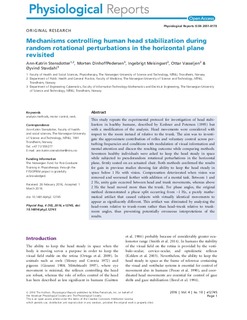| dc.contributor.author | Stensdotter, Ann-Katrin | |
| dc.contributor.author | Pedersen, Morten Dinhoff | |
| dc.contributor.author | Meisingset, Ingebrigt | |
| dc.contributor.author | Vasseljen, Ottar | |
| dc.contributor.author | Stavdahl, Øyvind | |
| dc.date.accessioned | 2020-03-06T13:02:26Z | |
| dc.date.available | 2020-03-06T13:02:26Z | |
| dc.date.created | 2016-06-08T21:55:23Z | |
| dc.date.issued | 2016 | |
| dc.identifier.citation | Physiological Reports. 2016, 4 (10), . | nb_NO |
| dc.identifier.issn | 2051-817X | |
| dc.identifier.uri | http://hdl.handle.net/11250/2645831 | |
| dc.description.abstract | This study repeats the experimental protocol for investigation of head stabilization in healthy humans, described by Keshner and Peterson (1995) but with a modification of the analysis. Head movements were considered with respect to the room instead of relative to the trunk. The aim was to investigate the approximate contribution of reflex and voluntary control across perturbing frequencies and conditions with modulation of visual information and mental attention and discuss the resulting outcome while comparing methods. Seventeen healthy individuals were asked to keep the head steady in space while subjected to pseudorandom rotational perturbations in the horizontal plane, firmly seated on an actuated chair. Both methods confirmed the results for gain in previous studies showing fair ability to keep the head steady in space below 1 Hz with vision. Compensation deteriorated when vision was removed and worsened further with addition of a mental task. Between 1 and 2 Hz, unity gain occurred between head and trunk movements, whereas above 2 Hz the head moved more than the trunk. For phase angles, the original method demonstrated a phase split occurring from ~1 Hz, a purely mathematical artifact that caused subjects with virtually identical movements to appear as significantly different. This artifact was eliminated by analyzing the head-room relative to trunk-room rather than head–trunk relative to trunkroom angles, thus preventing potentially erroneous interpretations of the results. | nb_NO |
| dc.language.iso | eng | nb_NO |
| dc.publisher | Wiley Open Access | nb_NO |
| dc.relation.uri | http://physreports.physiology.org/content/4/10/e12745 | |
| dc.rights | Navngivelse 4.0 Internasjonal | * |
| dc.rights.uri | http://creativecommons.org/licenses/by/4.0/deed.no | * |
| dc.subject | Medisinsk kybernetikk | nb_NO |
| dc.subject | Medical cybernetics | nb_NO |
| dc.title | Mechanisms controlling human head stabilization during random rotational perturbations in the horizontal plane revisited | nb_NO |
| dc.type | Journal article | nb_NO |
| dc.type | Peer reviewed | nb_NO |
| dc.description.version | publishedVersion | nb_NO |
| dc.subject.nsi | VDP::Medisinske fag: 700 | nb_NO |
| dc.subject.nsi | VDP::Midical sciences: 700 | nb_NO |
| dc.source.pagenumber | 12 | nb_NO |
| dc.source.volume | 4 | nb_NO |
| dc.source.journal | Physiological Reports | nb_NO |
| dc.source.issue | 10 | nb_NO |
| dc.identifier.doi | 10.14814/phy2.12745 | |
| dc.identifier.cristin | 1360420 | |
| dc.description.localcode | © 2016 The Authors. Physiological Reportspublished by Wiley Periodicals, Inc. on behalf of the American Physiological Society and The Physiological Society.This is an open access article under the terms of the Creative Commons Attribution License,which permits use, distribution and reproduction in any medium, provided the original work is properly cited. | nb_NO |
| cristin.unitcode | 194,65,20,0 | |
| cristin.unitcode | 194,65,30,0 | |
| cristin.unitcode | 194,63,25,0 | |
| cristin.unitname | Institutt for samfunnsmedisin og sykepleie | |
| cristin.unitname | Institutt for nevromedisin og bevegelsesvitenskap | |
| cristin.unitname | Institutt for teknisk kybernetikk | |
| cristin.ispublished | true | |
| cristin.fulltext | original | |
| cristin.qualitycode | 1 | |

